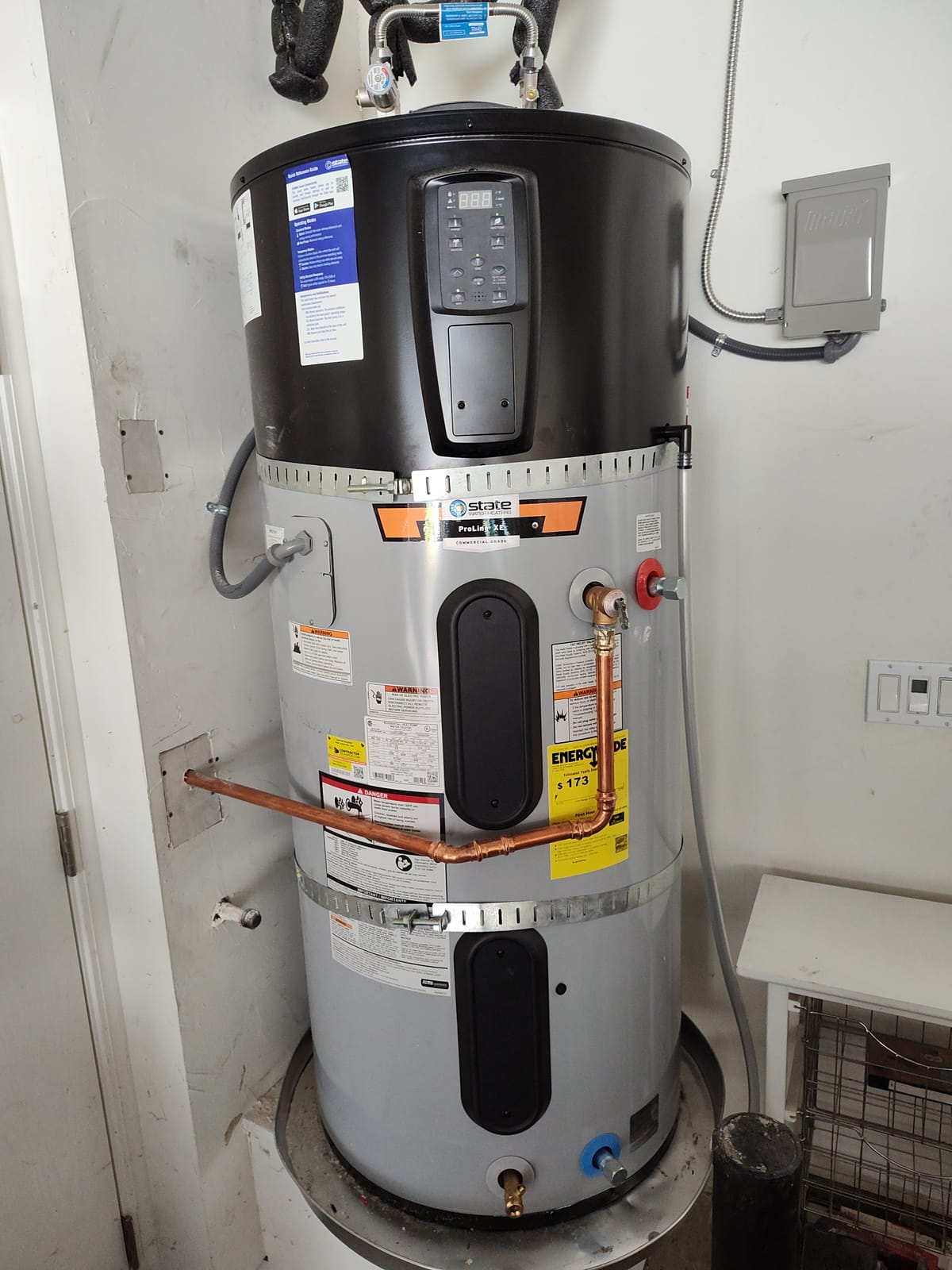Taking the emergency out of water heater replacement – and slashing emissions
A new program from a San Francisco Bay Area electricity provider gives homeowners critical time to select a water heater that is better for the planet.

One big concern lingers for any homeowner: When will your home’s water heater die? Live in a house long enough and the water heater will eventually fail, triggering a quick decision on a replacement and a prime opportunity to slash the home’s carbon footprint.
The problem for the planet is that more than 90% of these swap-outs are emergency replacements. The homeowner frantically calls plumbers, saying yes to the first one who promises to install a new water heater that same day. All too often, the plumber installs what is on the truck or in storage, typically a fossil gas-fired unit – locking in carbon pollution for the next 10-15 years.
A clever new program from a San Francisco Bay Area electricity provider aims to disrupt this status quo, buying homeowners critical time to select, and contractors to install, a water heater that is better for the planet.
MCE*, an electricity provider for three-dozen communities in Contra Costa, Marin, Napa, and Solano counties, launched a program in September that offers contractors a $1,500 per-unit cash incentive for the installation of an electric heat pump water heater after the installation of an emergency loaner. The $1,500 incentive is intended to cover contractors’ costs to maintain loaner water heaters (gas or electric) and additional labor or administrative costs associated with installing a heat pump water heater.
Contractors have up to 45 days to install the heat pump water heater to allow for contingencies. For instance, the homeowner may need to upgrade the home’s electric panel to accommodate a heat pump water heater.
“Most people, like 95 to 99% of folks, don’t do what you did, where they take the proactive step of replacing gas with electric. They wait until there’s an event where they must get the new water heater,” Jennifer Green, MCE’s manager of customer programs, told me in an interview. I had mentioned replacing my home’s aging gas-fired water heater as part of a larger electrification project last December.
“We were hearing from contractors that they were somewhat averse to offering the heat pump water heater, and by and large, ended up just installing the gas water heater, just for simplicity’s sake, and the customer getting back in hot water,” she added.
“From the customer’s perspective, we wanted them to be able to have hot water the same day. From the contractor’s perspective, we wanted them to be able to sell heat pump water heaters, and truly believe that they’re going to be an improvement in the customer’s life and lifestyle.”
Heat pump water heaters are at least two to three times more energy efficient than conventional electric resistance and gas-fired water heaters, so opting for one comes with substantial utility bill and carbon savings. If all electric resistance water heaters sold in the US were instead heat pump water heaters, it would save consumers $8 billion, and prevent 75 million tons of greenhouse gas emissions, annually, according to the ENERGY STAR program.
Successful pilots
MCE modeled its Emergency Water Heater Loaner Program on successful pilots completed in the city of Palo Alto and elsewhere in the San Francisco Bay Area.
Barnett Plumbing, a contractor operating in the greater Bay Area, installed nearly 150 heat pump water heaters under a 2022 pilot funded by a grant from the state’s TECH Clean California initiative. The program offered contractors $975 to cover the cost of installing and removing a loaner water heater.
Giving customers time to make an informed decision succeeded in driving heat pump adoption during the pilot: the rate of customers converting from gas water heaters to heat pump water heaters increased from less than 1% to 17%.
“The ability to provide an emergency replacement heat pump water heater solution that doesn’t inconvenience the customer is essential to moving California toward their carbon-neutral goals,” Barnett concluded.
Contractor buy-in
MCE sees the emergency loaner program as a bridge to help contractors and households prepare for new regulations that prohibit the sale of NOx-emitting (i.e. gas) water heaters in the Bay Area Air Quality Management District’s territory beginning in 2027. Next year, the California Air Resources Board will vote on a proposal to ban the sale of non-zero-emission water heaters statewide beginning in 2030.
MCE’s Green Workforce Pathways program aims to ensure that contractors have enough trained workers to keep up with heat pump water heater installations when the new rules take effect. The program pre-vets job seekers, matches them with contractors, and provides ongoing technical support for participating contractors.
“A lot of the work that needs to be done still is winning the hearts and minds of the contractor and providing them with the training they need to feel comfortable with installing heat pump water heaters,” Green told me.
Contractors that specialize in electrification projects don’t need convincing.
“I think the program is a great idea,” Alex Sloan, VP of Operations at Electrify My Home, told me in an email. Electrify My Home, which is based in Vacaville, California, completed my home electrification project, which included the installation of a State 66-gallon tank heat pump water heater to replace the original gas-fired water heater.
“The bit of advice/consulting we offered to MCE and others around emergency replacements is that instead of installing temporary gas water heaters, they should just skip the line and install 120-volt plugin water heaters since they don’t require 240v and can be installed quickly (even with a temporary extension cord if needed),” added Sloan. “And if the customers don’t like them, the program should offer a subsidy to upgrade to a 240v unit within a year.”
The path ahead
Green is optimistic both that homeowners will increasingly opt for heat pump water heaters and that manufacturers and contractors are preparing to meet the increased demand.
“Customer appetite is getting higher,” and the TECH Clean California initiative is pushing manufacturers to stock heat pump water heaters at distribution centers and on service trucks, she said.
Contractor buy-in is key because “people trust their contractor and their contractor’s recommendation.”
“We’re hoping that programs like our loaner program will entice the contractor at the midstream and incentivize those technologies.”
If that happens, MCE’s loaner program should thrive.
“The expectation is that the program is going to do really well. The pilot will succeed. We’ll see a lot of need, and then we will add funds to the budget.”
Referring to the initial $145,000 budget, she added, “I don’t foresee that that’s the last of the funding.”
*Disclosure: I’m a residential MCE customer. My wife Carlyn Obringer is the Vice Mayor of the city of Concord, California. Concord is an MCE member community, and while the Concord City Council designates a councilmember to sit on MCE’s Board of Directors, my wife does not currently serve on the MCE board.
Like what you are reading? Quitting Carbon is a reader-supported publication. To support my work, please consider becoming a paid subscriber or making a one-time donation. Thank you to all who have already subscribed!




